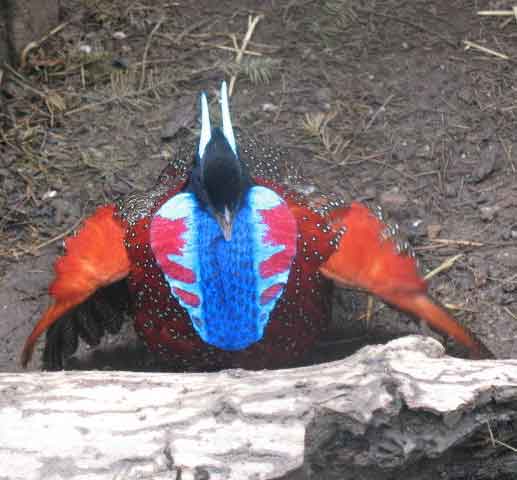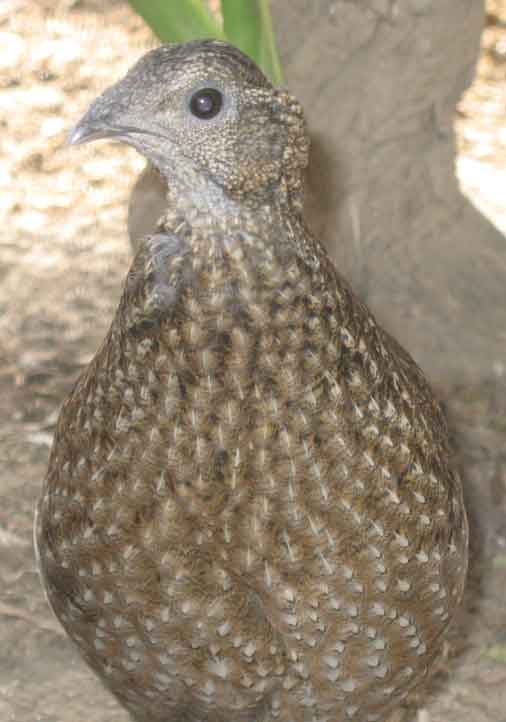
Tragopan satyra, male (*)
Superregnum: Eukaryota
Regnum: Animalia
Subregnum: Eumetazoa
Cladus: Bilateria
Cladus: Nephrozoa
Superphylum: Deuterostomia
Phylum: Chordata
Subphylum: Vertebrata
Infraphylum: Gnathostomata
Megaclassis: Osteichthyes
Superclassis: Sarcopterygii
Superclassis: Tetrapoda
Cladus: Reptiliomorpha
Cladus: Amniota
Classis: Reptilia
Cladus: Eureptilia
Cladus: Romeriida
Subclassis: Diapsida
Cladus: Sauria
Infraclassis: Archosauromorpha
Cladus: Crurotarsi
Divisio: Archosauria
Cladus: Avemetatarsalia
Cladus: Ornithodira
Subtaxon: Dinosauromorpha
Cladus: Dinosauriformes
Cladus: Dracohors
Cladus: Dinosauria
Ordo: Saurischia
Cladus: Eusaurischia
Cladus: Theropoda
Cladus: Neotheropoda
Cladus: Averostra
Cladus: Tetanurae
Cladus: Avetheropoda
Cladus: Coelurosauria
Cladus: Tyrannoraptora
Cladus: Maniraptoromorpha
Cladus: Maniraptoriformes
Cladus: Maniraptora
Cladus: Pennaraptora
Cladus: Paraves
Cladus: Eumaniraptora
Cladus: Avialae
Infraclassis: Aves
Cladus: Euavialae
Cladus: Avebrevicauda
Cladus: Pygostylia
Cladus: Ornithothoraces
Cladus: Euornithes
Cladus: Ornithuromorpha
Cladus: Ornithurae
Cladus: Carinatae
Parvclassis: Neornithes
Cohors: Neognathae
Cladus: Pangalloanserae
Cladus: Galloanseres
Ordo: Galliformes
Familia: Phasianidae
Subfamilia: Phasianinae
Genus: Tragopan
Species: Tragopan satyra
Name
Tragopan satyra (Linnaeus, 1758)
Synonyms
Meleagris satyra (protonym)

Tragopan satyra, female (*)
References
Linnaeus, C. 1758. Systema Naturae per regna tria naturæ, secundum classes, ordines, genera, species, cum characteribus, differentiis, synonymis, locis, Tomus I. Editio decima, reformata. Holmiæ: impensis direct. Laurentii Salvii. i–ii, 1–824 pp DOI: 10.5962/bhl.title.542: 157. Reference page.
Vernacular names
brezhoneg: Tragopan satir
català: Tragopan sàtir
čeština: Satyr himálajský
dansk: Satyrtragopan
Deutsch: Satyrtragopan
English: Satyr Tragopan
Esperanto: Karmezina tragopano
español: Tragopán sátiro
français: Tragopan satyre
magyar: Szatírtragopán
italiano: Tragopano satiro
日本語: ヒオドシジュケイ
Nederlands: Rood saterhoen
polski: Tragopan czerwony
پنجابی: سیٹائر ٹریگوپان
русский: Трагопан-сатир
svenska: Satyrtragopan
tp: Alassin Da Eaaiť
українська: Трагопан-сатир
Tiếng Việt: Gà lôi Satyr
中文: 红胸角雉
The satyr tragopan (Tragopan satyra) also known as the crimson horned pheasant, is a pheasant found in the Himalayan reaches of India, Tibet, Nepal and Bhutan. They reside in moist oak and rhododendron forests with dense undergrowth and bamboo clumps. They range from 2400 to 4200 meters in summer and 1800 meters in winter. The male is about 70 cm long.
When it is mating season, male satyr tragopans grow blue horns and a gular wattle. When ready to display, they will inflate their horns and hide behind a rock, waiting for females to pass by. When one does, they will perform an elaborate display in front of the females. At the end of the display, the male will stretch to his full height and show off all of his ornaments.[2]
Females are brown. Males are usually red with blue, black, and white spots and freckles.
Although the least threatened of the tragopans, satyr tragopans still face many threats. The species is thought to have a moderately small population that is subject to hunting and habitat loss throughout most of its range.[3]
Taxonomy
In 1750 the English naturalist George Edwards included an illustration and a description of the satyr tragopan in the third volume of his A Natural History of Uncommon Birds. He used the English name "The Horned Indian Pheasant". Edwards based his hand-coloured etching on the head of the bird preserved in alcohol and a drawing of the whole bird that had both been sent to the physician Richard Mead in London.[4] Edwards believed that the specimen had come from Bengal, but this is an error, the specimen probably came from Nepal.[5]
When in 1758 the Swedish naturalist Carl Linnaeus updated his Systema Naturae for the tenth edition, he placed the satyr tragopan with the wild turkey in the genus Meleagris. Linnaeus included a brief description, coined the binomial name Meleagris satyra and cited Edwards' work.[6] The satyr tragopan is now placed in the genus Tragopan that was introduced in 1829 by the French naturalist Georges Cuvier.[7][8] The species is monotypic: no subspecies are recognised.[8] The genus name is from Latin tragopan, a mythical horned purple-headed bird mentioned by the Roman authors Pliny and Pomponius Mela. The specific epithet satyra is from the Latin satyrus meaning "satyr", a Roman deity often depicted with horns.[9]
References
BirdLife International (2016). "Tragopan satyra". IUCN Red List of Threatened Species. 2016: e.T22679157A92804874. doi:10.2305/IUCN.UK.2016-3.RLTS.T22679157A92804874.en. Retrieved 12 November 2021.
Smith, C. Barnby (1912). "The display of the Satyr Tragopan Pheasant, Ceriornis satyra". Avicultural Magazine. 3 (6): 153–155.
"Satyr Tragopan (Tragopan satyra) - BirdLife species factsheet". Birdlife.org. Retrieved 30 June 2018.
Edwards, George (1750). A Natural History of Uncommon Birds. Vol. Part III. London: Printed for the author at the College of Physicians. p. 116, Plate 116.
Peters, James Lee, ed. (1934). Check-List of Birds of the World. Vol. 2. Cambridge, Massachusetts: Harvard University Press. p. 109.
Linnaeus, Carl (1758). Systema Naturae per regna tria naturae, secundum classes, ordines, genera, species, cum characteribus, differentiis, synonymis, locis (in Latin). Vol. 1 (10th ed.). Holmiae (Stockholm): Laurentii Salvii. p. 157.
Cuvier, Georges (1829). Le Règne animal distribué d'après son organisation : pour servir de base a l'histoire naturelle des animaux et d'introduction a l'anatomie comparée. Nouvel Édition, Revue et Augmentée (in French). Vol. 1. Paris: Déterville. p. 479.
Gill, Frank; Donsker, David; Rasmussen, Pamela, eds. (July 2021). "Pheasants, partridges, francolins". IOC World Bird List Version 11.2. International Ornithologists' Union. Retrieved 11 October 2021.
Jobling, James A. (2010). The Helm Dictionary of Scientific Bird Names. London: Christopher Helm. pp. 348, 389. ISBN 978-1-4081-2501-4.
Retrieved from "http://en.wikipedia.org/"
All text is available under the terms of the GNU Free Documentation License

